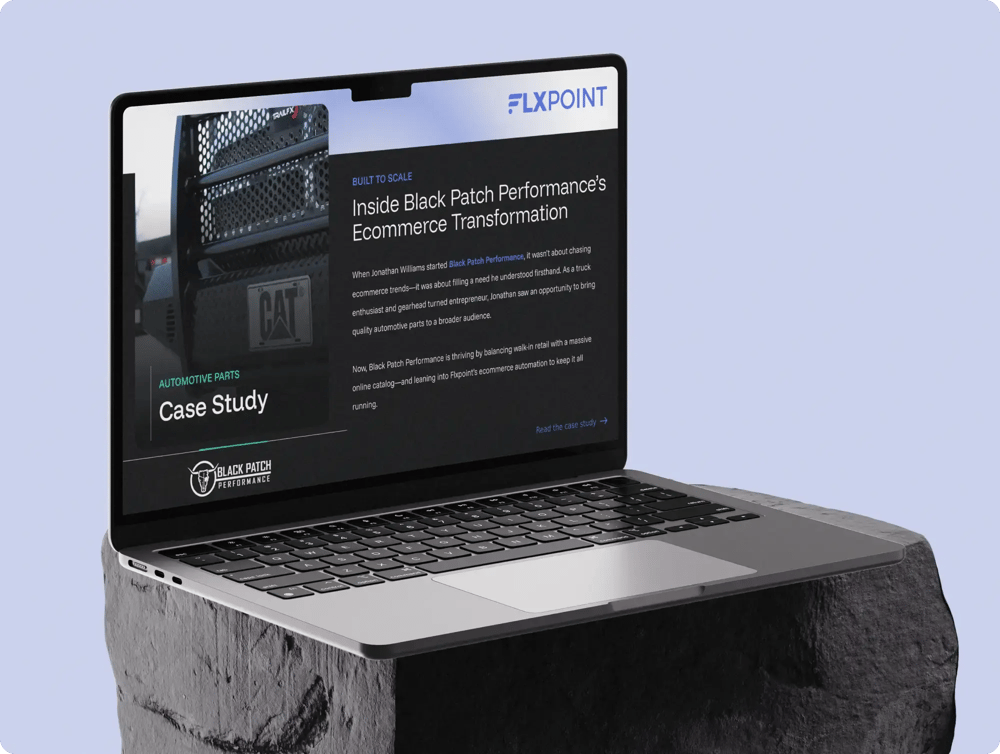Case Studies / Black Patch Performance
Built to Scale Inside Black Patch Performance’s Ecommerce Transformation

Industry
Automotive
About the Company
Founded in 2018 Black Patch Performance quickly became a top name in automotive parts, as well as the number one seller in the U.S.A. for several top product lines and brands.
Challenge
Outdated tools and unreliable product data made it nearly impossible for Black Patch to manage a growing catalog and supplier list.
Results
With Flxpoint, Black Patch now manages 500K+ SKUs with ease—cutting errors, improving data quality, and unlocking real ecommerce growth.
"The only way to actually scale was to go through Flxpoint… You can’t even come close to hiring someone to do what Flxpoint does for the price."
When Jonathan Williams started Black Patch Performance, it wasn’t about chasing ecommerce trends—it was about filling a need he understood firsthand. As a truck enthusiast and gearhead turned entrepreneur, Jonathan saw an opportunity to bring quality automotive parts to a broader audience. Now, Black Patch Performance is thriving by balancing walk-in retail with a massive online catalog—and leaning into Flxpoint’s ecommerce automation to keep it all running.
“We sell a little bit of everything automotive related,” says Jonathan. “But our primary stuff is more around the pickup trucks. A lot of times this ends up being the lifted ones or the diesel ones.”
What started as a hands-on, service-based business has evolved into a data-driven operation. “I used to [do installs], back when I first started the business, but pretty quickly learned that it wasn’t scalable,” he explains, referring to installs and hands-on service work.
Now? It’s all about product sales—both in-store and online.
Balancing Brick-and-Mortar & Online Sales
Black Patch Performance isn’t your typical local shop. Since opening, it’s already outgrown two locations, with its current storefront designed to be the long-term home base. “This place that we're at now, we have room to expand there,” says Jonathan.
That new location brought a surprising surge in walk-in sales.

“Before that spot, it was probably like 10 percent retail, 90 percent online. But after moving to this new location... it’s gotten to be like 30 percent retail and 70 percent online.”
Retail’s staying power also offers a buffer. “Our retail sales have been very consistent,” Jonathan says. “The online space where it's so competitive, it's not as consistent as I would like it to be. One thing that I'm working on is making the online space a lot more consistent for us.”
Leveraging Dropshipping—The Smart Way
Online growth means one thing for Jonathan: scale through dropshipping. “I'm like 99.9 percent dropship,” he states plainly. But unlike many online sellers, he’s not just passing along supplier feeds. He’s using the power of his retail presence to negotiate better terms.
“We've been able to use the retail store to kind of strategically stock stuff and get some volume discounts that also apply to our dropship side of things,” he shares. That strategy unlocks better margins and gives him a tactical edge online.
Another perk? Product insight. “Where we spent a lot more time in the beginning in the e-commerce side, the dropship side, we were just passing through products,” he says. “We didn't necessarily see a ton of the products, but now we can kind of get some of those products in, get pictures.”
How A Brick & Mortar Location Builds Trust
That hands-on advantage leads to better buying and builds trust. Part of that is having an in-person retail store where it is easier to verify the quality of the products their brands are offering.
He uses a tire brand as an example: “They always made lower tier tires. Well, they've made a big transition right before COVID and kind of throughout COVID that changed their brand for the better. And now they're coming up as one of the higher end tires.”
“You wouldn't have really known that unless you ran the tires through the retail store, like actually put your hands on them, actually saw the difference, actually heard the retail customer feedback of the people that you see in your local area, running them on their vehicle and hearing back from them person to person. So that is one of the big advantages of the retail location.”
Managing 500K SKUs Without Losing Sleep
Automation isn’t optional when you’re managing half a million SKUs. “I think right now we have about a half a million SKUs. We're only pushing about 120,000 of those SKUs to our actual Shopify site,” says Jonathan.
Why not just upload everything? Strategy.
“The biggest reason is because Shopify limits [us to] only posting a thousand new SKUs per day. So we're actually looking to upgrade to Shopify plus to get around some of those limits. Another [reason] is a lot of the products, even though they're there, they're not always in stock. So I don't really want to clog up my already crowded website with a bunch of out of stock products.”
Still, Jonathan isn’t afraid of a big catalog. “We have about a hundred and twenty thousand products actually on the site right now, which is already a massive catalog. But I think I would like to grow it even more. I probably want to end up with around two hundred fifty thousand,” he admits with a grin. “But if we can do it in a way that keeps everything organized... it could be a massive thing for our business!”
Why Black Patch Chose Flxpoint Over the Rest
Before Flxpoint, Jonathan was stuck with a supplier that made scaling nearly impossible. “They specialized in automotive data,” he says. “it was all hands off and they managed it for us, which was nice in a sense, but it meant there was no scaling the business.” Pricing was generic, data inconsistent, and when products were discontinued his site didn’t update correctly.
“We ran into a problem [with product data]... It would just sit there at the last inventory amount that it pulled from that sheet or that data, and it would just sit there indefinitely.,” he explains. That led to awkward calls and canceled orders—something no business wants.
Flxpoint fixed that.

“With Flxpoint... if the data isn’t there, it pulls it back until the data comes back up again and then it unarchives it. That's the way Flxpoint works. That's really the way it should work.”
He considered a cheaper competitor, but the interface didn’t cut it. “It looked like it was built on Windows 98,” he jokes. Flxpoint felt familiar and powerful.
“Your competition didn’t have half the features you guys do,” he says. “So Flxpoint has a lot more capabilities and is like definitely a lot harder to use if you want to use it to its full potential, but at the same time I would say it's easier to use just because of the way it's set up and kind of the way you can see and feel and touch and move everything inside of the system. So for me, that was kind of a really nice thing with Flxpoint.”
Cleaning Up Automotive’s Product Data
Anyone who’s dealt with auto parts catalogs knows the data is rough. “In the automotive space, the SKUs, the UPCs, automotive data is horrible. Even some of the data that comes in from the nice companies like SEMA, like DCI,” he admits. “it can really kind of be a shit show.”
His solution? Flxpoint’s reference identifiers. “I ended up having to use reference IDs as kind of my primary way to match the SKUs,” he says. It wasn’t simple—some suppliers had confusing overlaps. AMP vs AMP Research, for example. “We changed it to the first four [letters]. And that is enough of a differentiator.”
He also builds custom product titles using Flxpoint’s rules engine. “Instead of 10 different columns that say all this different stuff, it actually reads 20 by 12, eight by 170, gear off-road, cali off-road, wheel, negative 81 offset. It reads in a pretty way, based off of all the random columns that they've given us,” says Jonathan. What used to be a manual spreadsheet grind is now just an upload.
The ROI Is in the Automation
The cost of an automation tool wasn't part of the equation in how Jonathan moved forward. In his eyes, the return on investment was eliminating manual work.
“You can’t hire any competent employee to manually manage... the data that can be managed in Flxpoint for the price that it’s being done at,” he argues. “We don’t have many errors — If we do, [your] support catches them before I do.”
And for someone managing everything himself, that peace of mind is invaluable. “The biggest roadblocks that I’m facing in Flxpoint are not Flxpoint related—it’s supplier data related,” he adds.
“Flxpoint upfront was a little bit bigger of an investment, especially as a small business. But the way I looked at it is, it was the only way to actually scale.”
Building for the Future with Recurring Revenue
Looking ahead, Jonathan is focused on building more stability into the business. “My biggest thing is trying to get rid of some of that inconsistency,” he says. That includes experimenting with a recurring revenue model — something he believes could be a game changer in automotive retail.
“But I think we have a really cool way to, as our business, build a monthly recurring revenue inside the automotive space, which is, like I said, very abnormal,” he explains.
He’s also expanding his use of financing tools. “Not everyone has two or $3,000 sitting in their pocket to make a purchase like that without it kind of affecting their financial status or whatever,” Jonathan shares. “So if you can break that payment into smaller chunks, and then a lot of our payment plan providers that we work with usually have like some kind of 90 day, same as cash option or early pay off no interest option. Like that, that's been huge for a lot of customers.”
And above all, he’s continuing to invest in better product data and customer experience. He notes that their industry is highly competitive. “We’re really going to have to work our asses off to make our product data better, build our brand to be a trusted brand,” he says.

Ready to Automate Like Black Patch Performance?
Jonathan Williams didn’t just grow his business, he transformed how it runs. By combining hands-on retail experience with a powerful ecommerce backend, he’s created a model that’s not just surviving in a competitive space, but thriving. And Flxpoint is a big part of that equation.
Whether you’re managing a huge catalog, wrangling unreliable supplier data, or trying to scale without adding headcount, Jonathan’s story proves what’s possible when you have the right automation partner on your side.
If you're ready to stop managing spreadsheets and start scaling smarter, book a personalized demo today and see how we can help you automate, optimize, and grow—just like Black Patch Performance.
SEE IT IN ACTION Get the Full Black Patch Performance Case Study
Want to save this for later and discover how Black Patch scaled faster and simplified operations but don't have time right now? Get the full PDF version to see how Jonathan automates 500K+ SKUs, improves product data, and scales smarter with Flxpoint—no spreadsheets, no stress.



